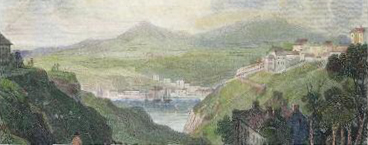
Discover Your Ancestors
Two critically acclaimed publications are available to family history researchers - the annual print magazine, Discover Your Ancestors, and the monthly online magazine, Discover Your Ancestors Periodical. Click here to subscribe.Pembrokeshire

Pembrokeshire is a divided land in a unique way. Straggling across the county, roughly from the upper inland corner of St Bride’s Bay in the west to the middle of Carmarthen Bay in the west is a phenomenon known as the Landsker Line. This marks a linguistic and cultural boundary that has its origins in Norman times.
The area north of the line – a surprisingly narrow continuum (generally two to four miles wide) – is predominantly Welsh-speaking. The chief settlements are St David’s and Fishguard, and the area is still mostly rural today, especially the wilds of Strumble Head (Pencaer).
To the south lies what has been known as ‘Little England Beyond Wales’ since at least the 16th century, where Welsh has traditionally been more rarely spoken and the cultural focus is more related to the south-west of England. The chief settlements here are Milford Haven, Pembroke and Tenby.
Pembrokeshire lays claim to being the birthplace of the Tudor dynasty – Henry Tudor (Henry VII) was born at Pembroke Castle in 1457. Less than two centuries later, however, after the end of Henry’s line, Pembrokeshire took against the monarchy and supported Cromwell in the British Civil Wars, although the rest of Wales was broadly Royalist. The most notable event of these wars in the region was the siege of Pembroke in 1648, where the Royalists held out, protected by Pembroke Castle’s thick walls and elevated position, until Cromwell cut off their water supply.
Pembrokeshire is home to Britain’s smallest city, St David’s, which even today only has around 1800 inhabitants. Wales’s patron saint was supposedly born nearby, and founded a monastery in the 6th century. The current building was erected by the Normans, and houses David’s relics to this day.
Inevitably, with around 200 miles of coastline, Pembrokeshire has a strong maritime history. Fishguard was known for the herring trade with Ireland, Bristol and Liverpool, as well as exporting oats; Tenby exported wool, canvas, coal and iron; the inland port of Haverfordwest was the second largest in Wales in Tudor times, and exported coal, slate, butter, oats and wool, among other things, although its sea trade ultimately declined after the railway arrived in 1853. Herring and salmon were fished at St Dogmaels. Newport, too, exported wool, cloth, slate and the ubiquitous herring.
Milford Haven was originally a whaling port, founded in the late 18th century with the help of three American whaling families, the Starbucks, Folgers and Rotches. The whale oil they produced was used to light the streets of London. The Royal Navy founded a dockyard there, before moving it to Pembroke in 1814, and the town’s protected harbour made it an important naval base in both world wars.
Milford was also the port of departure for both Henry II’s and Oliver Cromwell’s invasions of Ireland. In the 20th century it saw immigrant communities of Belgians, Germans, Italians, Poles and Latvians settling.
Industry has been important in parts of Pembrokeshire, too. The north coastal village of Porthgain is still dominated by the hulking ruins of its brickworks; its harbour was originally built in 1851 to export local slate; and in the early 20th century its stone was used to surface roads across the UK. Similarly, in Goodwick there was a thriving brickworks (until the 1960s), which reached a peak production of 120,000 a week during World War 2.
Limestone was quarried and coal mined in the area around Narberth and Saundersfoot, although the Pembrokeshire pits had all closed by the end of the 1930s. Saundersfoot also had an ironworks and a firebrick factory.
Agriculture has long been significant in the county, too: there are still working woollen mills at Tregwynt and Solva recalling a much larger industry in the past, and the fairly mild climate continues to make it a notable exporter of new potatoes.
Exclusive census analysis from the data at TheGenealogist.co.uk reveals that common 19th century surnames in Pembrokeshire (removing those common across all of Wales) include William, John, Griffith, Bevan, Richard, Jenkin, Harries and Howells.
Pembrokeshire Records Online
Leading data website TheGenealogist.co.uk has a wealth of records for Pembrokeshire. Here is a quick run-down of what you can find (in addition to national collections):
- Trade directories: Pigot’s directories for Wales, 1835 and 1844, plus a South Wales telephone directory from 1938.
- Census records: Pembrokeshire records for every census from 1841 to 1911.
- Nonconformist registers: Nonconformist chapels and meeting houses across Pembrokeshire are covered in the site’s collections.
- Land owners: the site’s huge collection of tithe commutation records includes Pembrokeshire , along with tithe maps; plus an 1873 survey of Welsh and English landowners includes the region.
- Wills: many people from Pembrokeshire can be found in Prerogative Court of Canterbury (PCC) Wills 1384-1858.